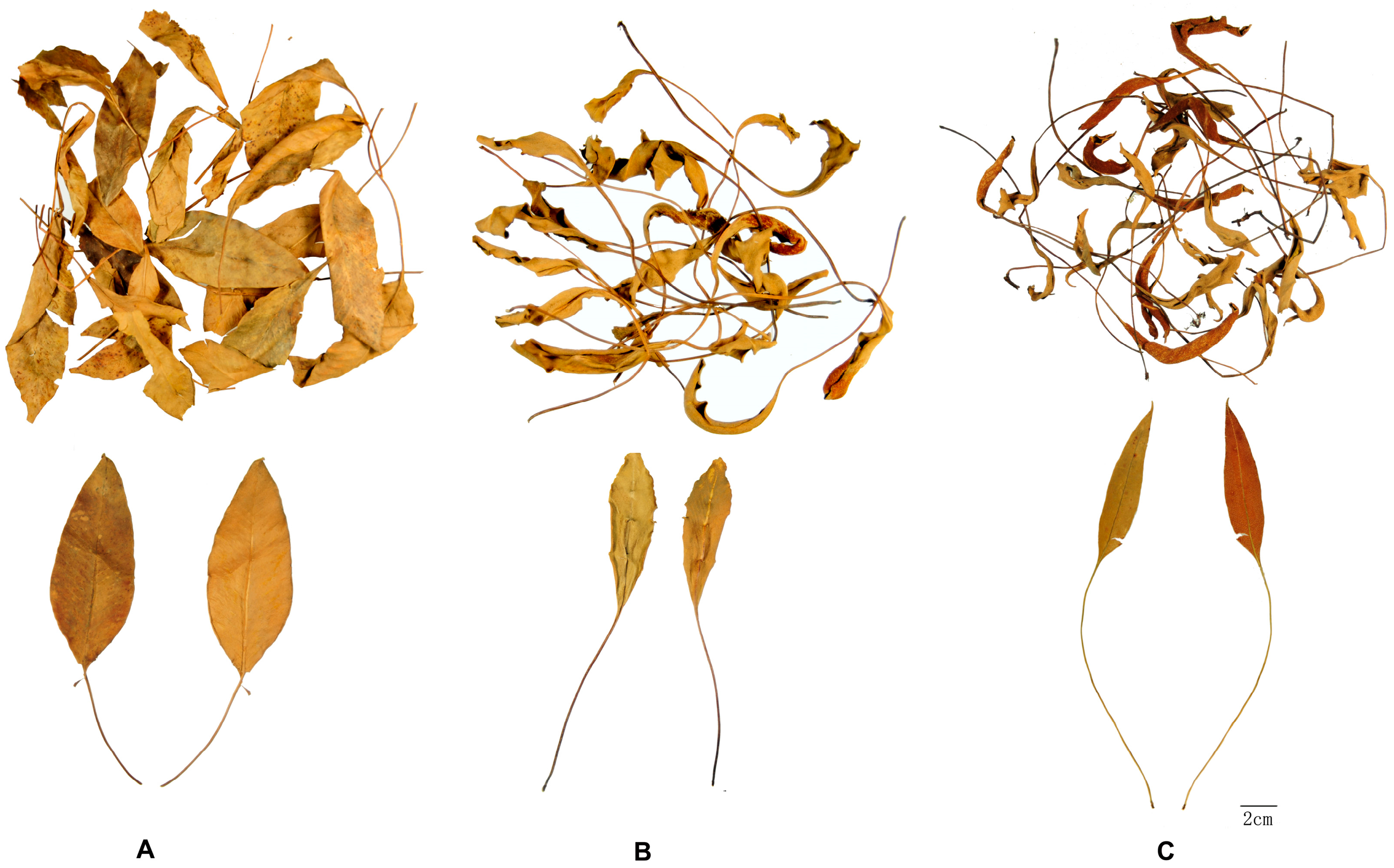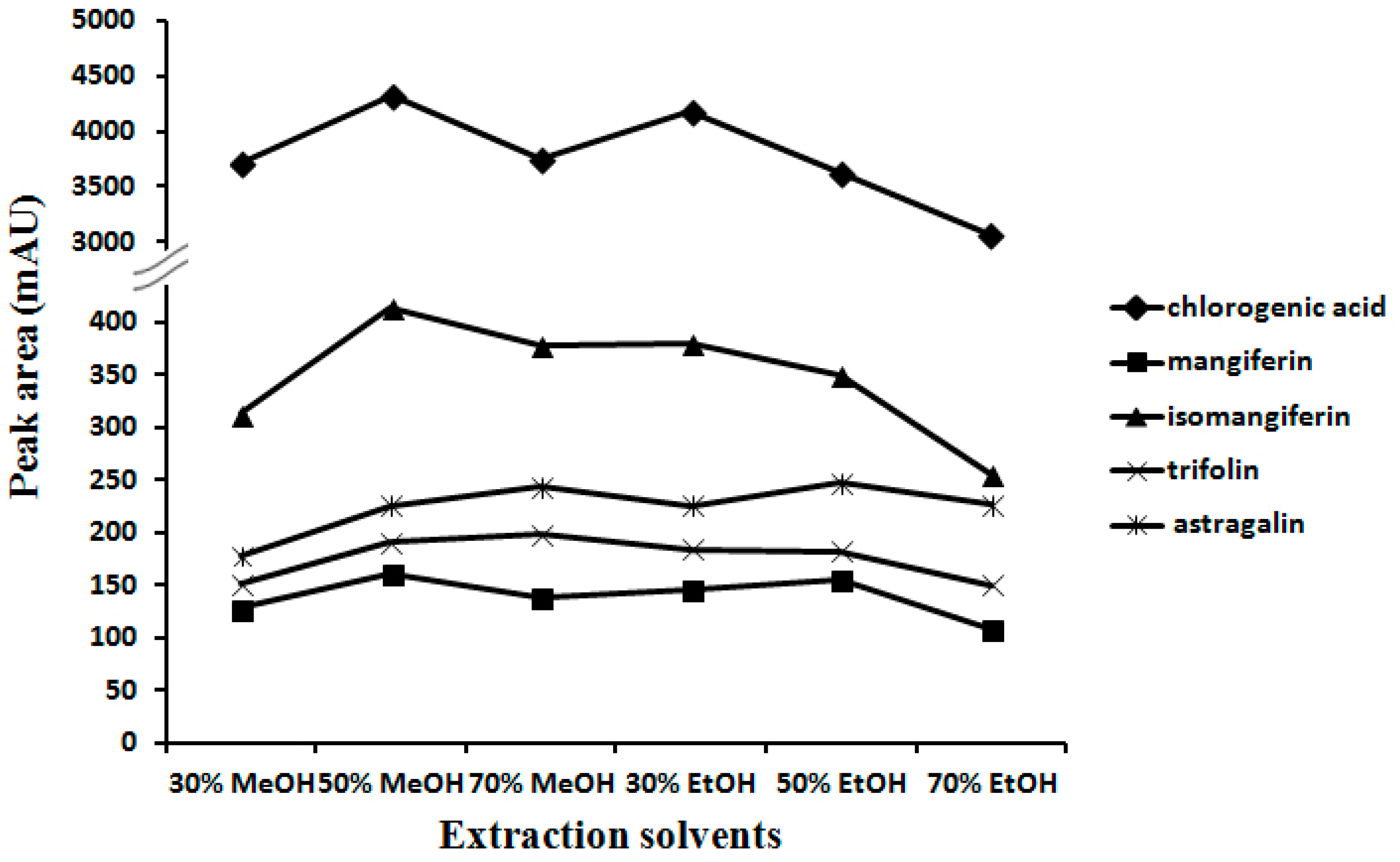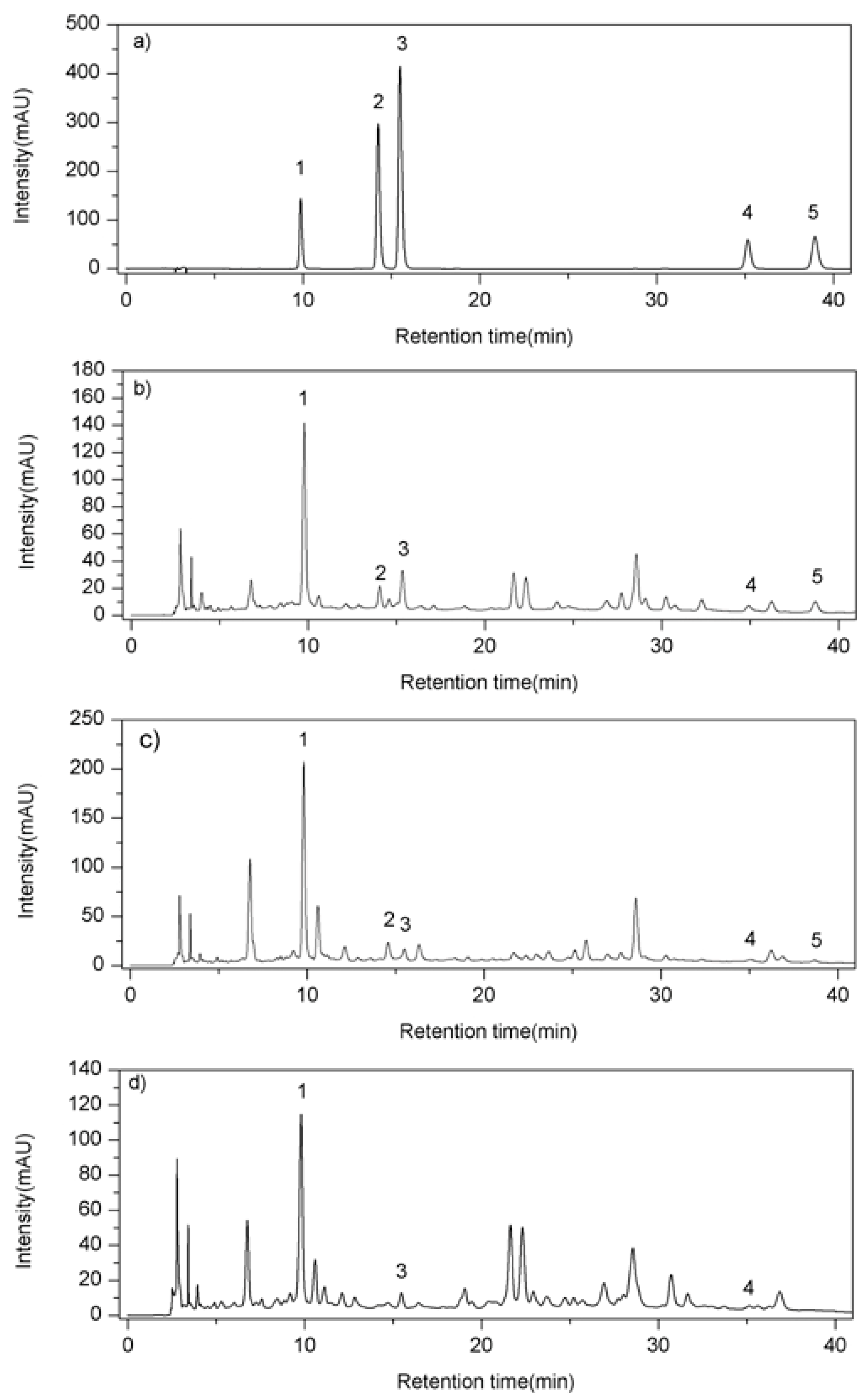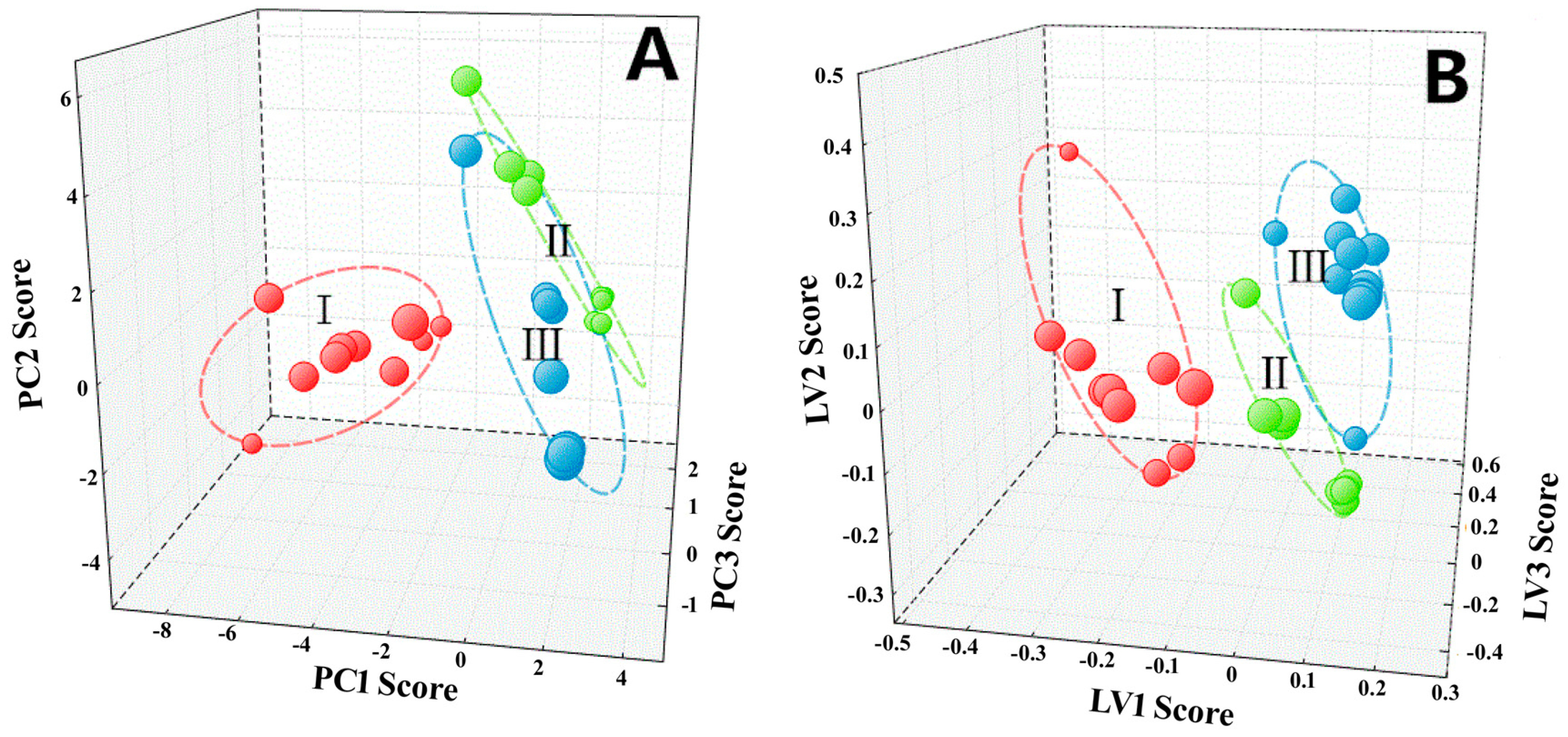Comparative Evaluation of Chemical Profiles of Pyrrosiae Folium Originating from Three Pyrrosia Species by HPLC-DAD Combined with Multivariate Statistical Analysis
Abstract
:1. Introduction
2. Results
2.1. Optimization of Extraction Conditions
2.2. Optimization of Chromatographic Conditions
2.3. Method Validation
2.4. Sample Analysis
2.5. Multivariate Statistical Analysis
3. Discussion
4. Materials and Methods
4.1. Reagents and Materials
4.2. Instrumentation and Liquid Chromatography
4.3. Preparation of Standard and Sample Solutions
4.4. Method Validation
4.5. Multivariate Statistic Analysis
Acknowledgments
Author Contributions
Conflicts of Interest
References
- State Pharmacopoeia Committee of People’s Republic of China. Pharmacopoeia of the People's Republic of China, 10th ed.; China Medical Science and Technology Press: Beijing, China, 2015; p. 90. [Google Scholar]
- Hsu, C.Y. Antioxidant activity of Pyrrosia petiolosa. Fitoterapia 2008, 79, 64–66. [Google Scholar] [CrossRef] [PubMed]
- Li, Y.C.; Li, H.; Chen, C.J. Study on antifungal activities of alcohol extract of Pyrrosiae Folium. Lishizhen Med. Mater. Med. Res. 2010, 21, 142–143. [Google Scholar]
- Cheng, D.D.; Zhang, Y.Y.; Gao, D.M. Antibacterial and anti-inflammatory activities of extract and fractions from Pyrrosia petiolosa (Christ et Bar.) Ching. J. Ethnopharmacol. 2014, 155, 1300–1305. [Google Scholar] [CrossRef] [PubMed]
- Ma, Y.; Tiao, Y.; Yao, X.Q. Experimental study on antibradyarrhythmias of Pyrrosiae Folium. Jilin J. Tradit. Chin. Med. 2011, 79, 915–916. [Google Scholar]
- Shao, S.F.; Weng, Z.L.; Li, C.D. Inhibition effect of Chinese traditional medicine Lysimachina, Christina, Pyrrosia and Plantago on urinary calcium oxalate stone formation in rats. Chin. J. Integr. Tradit. West Nephrol. 2009, 10, 874–876. [Google Scholar]
- Li, J.; Tong, Y.Y.; Xing, G.X. Botanical resource investigation and quality assessment on Pyrrosiae Folium. Chin. J. Chin. Mater. Med. 1991, 16, 520–522. [Google Scholar]
- Lewandowska, H.; Kalinowska, M.; Lewandowski, W.; Stępkowski, T.M.; Brzóska, K. The role of natural polyphenols in cell signaling and cytoprotection against cancer development. J. Nutr. Biochem. 2016, 32, 1–19. [Google Scholar] [CrossRef] [PubMed]
- Liang, N.; Kitts, D.D. Role ofchlorogenic acids in controlling oxidative and inflammatory stress conditions. Nutrients 2016, 8, 16. [Google Scholar] [CrossRef] [PubMed]
- Hin, H.S.; Satsu, H.; Bae, M.J. Anti-inflammatory effect of chlorogenic acid on the IL-8 production in Caco-2 cells and the dextran sulphate sodium-induced colitis symptoms in C57BL/6 mice. Food Chem. 2015, 168, 167–175. [Google Scholar]
- Fuentes, E.; Palomo, I. Mechanisms of endothelial cellprotection by hydroxycinnamic acids. Vasc. Pharmacol. 2014, 63, 155–161. [Google Scholar] [CrossRef] [PubMed]
- Meng, S.; Cao, J.; Feng, Q.; Peng, J.; Hu, Y. Roles of chlorogenicacid on regulating glucose and lipids metabolism: A review. Evid. Based Complement. Altern. Med. 2013, 2013, 801457. [Google Scholar] [CrossRef] [PubMed]
- Li, Y.H.; Peng, J.D.; Zheng, M.; Zhang, Z.Y. Simultaneous determination of chlorogenic acid, mangiferin and luteolin in Pyrrosia lingua leaves. J. Southwest Chin. Norm. Univ. 2011, 36, 1–4. [Google Scholar]
- Zhang, Y.X.; Li, K.T.; Li, Q.Y.; Shi, Y. Identification of Folium Pyrrosiae from different habitats and species by HPLC fingerprint. J. Chin. Med. Mater. 2011, 34, 20–26. [Google Scholar]
- Ren, B.; Sun, H.Y.; Wang, H. Simultaneous determination of seven caffeoylquinic acids and three flavonoids in Pyrrosia petiolosa (Christ) Chingby RP-UFLC-DAD. J. Chin. Pharm. Sci. 2014, 23, 642–648. [Google Scholar] [CrossRef]
Sample Availability: Reference standards and parts of herbal samples are available from the authors. |





| Analytes | Regression Equation | r2 | Linear Range (μg/mL) | LOD (μg/mL) | LOQ (μg/mL) |
|---|---|---|---|---|---|
| Chlorogenic acid | y = 20.427x − 20.31 | 0.9995 | 2.89–289.4 | 0.053 | 0.178 |
| Mangiferin | y = 81.058x − 38.27 | 0.9996 | 1.16–116.4 | 0.014 | 0.047 |
| Isomangiferin | y = 61.572x − 46.64 | 0.9997 | 2.29–228.8 | 0.030 | 0.101 |
| Trifolin | y = 32.979x − 16.29 | 0.9996 | 0.96–95.9 | 0.085 | 0.284 |
| Astragalin | y = 42.194x − 18.94 | 0.9996 | 0.99–98.6 | 0.047 | 0.155 |
| Analyte | Inter-Day (n = 3) | |||||||
|---|---|---|---|---|---|---|---|---|
| Day 1 | Day 2 | Day 3 | Mean ± SD a | RSD (%) | ||||
| Mean ± SD a | RSD (%) | Mean ± SD a | RSD (%) | Mean ± SD a | RSD (%) | |||
| 1 | 4426.51 ± 43.32 | 0.98 | 4453.84 ± 50.76 | 1.14 | 4471.57 ± 34.61 | 0.77 | 4450.64 ± 45.01 | 1.01 |
| 2 | 165.53 ± 1.49 | 0.90 | 167.74 ± 2.37 | 1.41 | 168.41 ± 1.45 | 0.86 | 167.23 ± 2.59 | 1.27 |
| 3 | 421.83 ± 5.39 | 1.28 | 424.56 ± 4.18 | 0.99 | 424.45 ± 2.18 | 0.51 | 423.61 ± 4.10 | 0.97 |
| 4 | 189.11 ± 4.56 | 2.40 | 182.85 ± 3.78 | 2.06 | 183.91 ± 3.42 | 1.85 | 185.29 ± 4.66 | 2.50 |
| 5 | 246.56 ± 5.69 | 2.31 | 244.02 ± 5.78 | 2.37 | 241.47 ± 5.72 | 2.37 | 244.02 ± 5.79 | 2.37 |
| Analyte | Amount Spiked (μg/mL) | Amount Detected a (μg/mL) | Recovery b (%) | RSD (%) |
|---|---|---|---|---|
| 5.79 | 5.84 | 100.95 | 2.90 | |
| 1 | 11.58 | 12.04 | 104.00 | 2.99 |
| 115.76 | 114.14 | 98.60 | 2.30 | |
| 2.33 | 2.34 | 100.66 | 0.72 | |
| 2 | 4.66 | 4.58 | 98.33 | 2.41 |
| 46.56 | 47.85 | 102.78 | 1.62 | |
| 4.58 | 4.70 | 102.93 | 2.61 | |
| 3 | 9.15 | 9.11 | 99.58 | 0.87 |
| 91.52 | 92.04 | 100.57 | 1.90 | |
| 1.92 | 1.89 | 100.56 | 3.48 | |
| 4 | 3.84 | 3.89 | 101.41 | 3.44 |
| 38.35 | 38.60 | 100.66 | 1.65 | |
| 1.97 | 1.93 | 97.76 | 4.21 | |
| 5 | 3.94 | 3.82 | 97.35 | 2.27 |
| 39.44 | 36.74 | 93.16 | 1.80 |
| Analyte | Mixture Stock Solution | Sample Solution | (Batch 1) | |
|---|---|---|---|---|
| Mean ± SD a | RSD (%) | Mean ± SD b | RSD (%) | |
| 1 | 113.62 ± 1.22 | 1.07 | 4478.43 ± 37.56 | 0.84 |
| 2 | 45.62 ± 0.65 | 1.42 | 167.53 ± 2.13 | 1.27 |
| 3 | 89.97 ± 0.92 | 1.02 | 425.11 ± 4.14 | 0.97 |
| 4 | 37.41 ± 0.61 | 1.63 | 186.48 ± 3.21 | 1.71 |
| 5 | 36.82 ± 0.58 | 1.57 | 245.12 ± 3.54 | 1.45 |
| Species | Sample No. | Contents of Compounds 1–5 (μg/g) a | ||||
|---|---|---|---|---|---|---|
| 1 | 2 | 3 | 4 | 5 | ||
| P. sheareri | 1 | 4349.03 | 170.03 | 421.61 | 184.29 | 237.55 |
| 2 | 4070.53 | 5400.74 | 10,916.67 | 108.47 | 275.21 | |
| 3 | 3895.50 | 358.32 | 1026.59 | 103.93 | 176.88 | |
| 4 | 3760.14 | 427.28 | 1334.93 | 103.27 | 198.27 | |
| 5 | 2190.22 | 320.00 | 916.24 | 106.03 | 338.69 | |
| 6 | 5187.23 | 361.85 | 986.24 | 114.78 | 332.41 | |
| 7 | 4493.57 | 390.55 | 1017.95 | 121.04 | 219.57 | |
| 8 | 4931.57 | 434.99 | 1118.37 | 121.30 | 209.62 | |
| 9 | 4104.04 | 406.10 | 1148.48 | 110.96 | 202.33 | |
| 10 | 3549.57 | 259.43 | 770.29 | 118.30 | 101.60 | |
| Mean | 4053.14 | 852.93 | 1965.74 | 119.24 | 229.23 | |
| P. lingua | 11 | 5802.53 | 93.37 | 297.25 | 114.03 | 89.40 |
| 12 | 7277.73 | 57.39 | 72.84 | 526.78 | ND b | |
| 13 | 8957.35 | 58.91 | 126.41 | 1097.87 | 117.89 | |
| 14 | 9780.12 | 57.32 | 103.14 | 943.82 | ND | |
| 15 | 9672.51 | 57.52 | 93.65 | 889.28 | ND | |
| 16 | 8089.00 | 99.35 | 121.52 | 571.26 | ND | |
| 17 | 1507.21 | ND | 82.32 | 141.60 | ND | |
| 18 | 4308.91 | ND | 164.21 | 125.48 | 120.16 | |
| 19 | 8935.14 | 52.87 | 123.71 | 1194.43 | 113.58 | |
| 20 | 5652.18 | ND | 185.12 | 100.61 | 72.17 | |
| Mean | 6998.27 | 68.10 | 137.02 | 570.52 | 102.64 | |
| P. petiolosa | 21 | 8424.82 | 84.06 | 97.19 | 691.07 | ND |
| 22 | 3753.03 | ND | 145.33 | 93.06 | ND | |
| 23 | 3634.47 | ND | 152.79 | 76.35 | ND | |
| 24 | 4248.43 | ND | 153.01 | ND | ND | |
| 25 | 4561.98 | ND | 121.86 | ND | ND | |
| 26 | 3748.44 | ND | 117.55 | 89.88 | ND | |
| 27 | 10990.55 | 121.23 | 98.77 | 1012.30 | ND | |
| 28 | 9693.31 | 86.58 | 94.23 | 1043.10 | ND | |
| 29 | 11,448.08 | 121.55 | 101.64 | 1163.98 | ND | |
| 30 | 11,172.10 | 129.29 | ND | 1069.24 | ND | |
| 31 | 9253.95 | 76.66 | 87.09 | 784.87 | ND | |
| 32 | 10,069.68 | 107.30 | 92.70 | 1032.65 | ND | |
| 33 | 7440.68 | 83.13 | ND | 1015.50 | ND | |
| 34 | 9464.51 | 114.53 | ND | 943.21 | ND | |
| 35 | 8012.01 | 73.75 | 86.57 | 654.62 | ND | |
| Mean | 7727.74 | 99.81 | 112.39 | 743.83 | ND | |
© 2017 by the authors. Licensee MDPI, Basel, Switzerland. This article is an open access article distributed under the terms and conditions of the Creative Commons Attribution (CC BY) license (http://creativecommons.org/licenses/by/4.0/).
Share and Cite
Xiao, W.; Peng, Y.; Tan, Z.; Lv, Q.; Chan, C.-o.; Yang, J.; Chen, S. Comparative Evaluation of Chemical Profiles of Pyrrosiae Folium Originating from Three Pyrrosia Species by HPLC-DAD Combined with Multivariate Statistical Analysis. Molecules 2017, 22, 2122. https://doi.org/10.3390/molecules22122122
Xiao W, Peng Y, Tan Z, Lv Q, Chan C-o, Yang J, Chen S. Comparative Evaluation of Chemical Profiles of Pyrrosiae Folium Originating from Three Pyrrosia Species by HPLC-DAD Combined with Multivariate Statistical Analysis. Molecules. 2017; 22(12):2122. https://doi.org/10.3390/molecules22122122
Chicago/Turabian StyleXiao, Wei, Yude Peng, Zhexu Tan, Qiuyue Lv, Chi-on Chan, Jingyu Yang, and Sibao Chen. 2017. "Comparative Evaluation of Chemical Profiles of Pyrrosiae Folium Originating from Three Pyrrosia Species by HPLC-DAD Combined with Multivariate Statistical Analysis" Molecules 22, no. 12: 2122. https://doi.org/10.3390/molecules22122122




